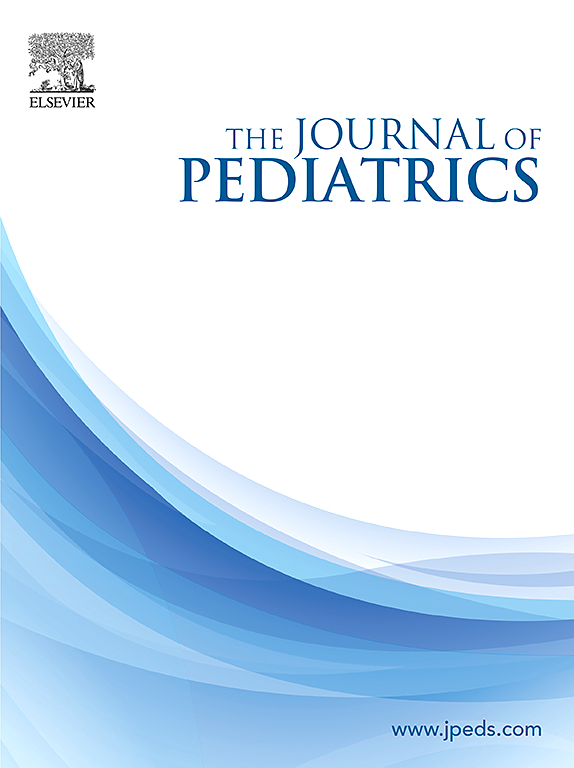高危住院婴儿回顾性队列中阿片类药物相关药物基因组变异
IF 3.5
2区 医学
Q1 PEDIATRICS
引用次数: 0
摘要
目的:评估阿片类药物相关药物基因组学(PGx)变异在高危住院婴儿中的流行程度,并将这些频率与更广泛的遗传队列进行比较,以评估精确开具阿片类药物处方的意义。研究设计:这项回顾性队列研究纳入了111名高危婴儿(62.2%为男性,47.7%为西班牙裔/拉丁裔,18.0%为早产儿,82.0%为先天性心脏病),其中68.2%接受了手术。总体而言,81.1%的婴儿是至少一种阿片类药物相关PGx变异的纯合子。与Ensembl数据相比,我们队列中的婴儿ABCB1: rs1045642的纯合子频率明显更高(43.6% vs 18.7%)。结论:在我们的队列中,大多数婴儿携带至少一种阿片类药物相关的PGx变异,其频率与更广泛的遗传队列有显著差异。这些发现强调了pgx引导的阿片类药物处方在优化疼痛管理和减少不良反应方面的潜力。需要更大规模的纳入内含子PGx变异和祖先可比对照的研究来验证这些发现并评估临床意义。本文章由计算机程序翻译,如有差异,请以英文原文为准。
Opioid-Related Pharmacogenomic Variants in a Retrospective Cohort of High-Risk Hospitalized Infants
Objective
To evaluate the prevalence of opioid-related pharmacogenomic (PGx) variants in high-risk hospitalized infants and to compare these frequencies with broader genetic cohorts to assess implications for precision opioid prescribing.
Study design
This retrospective cohort study included infants <1 year of age with high-risk conditions treated at a quaternary children's hospital between 2009 and 2020 who underwent exome sequencing. Variants associated with opioid response (COMT, DRD2/ANKK1, ABCB1, OPRM1, CYP2B6, and CYP2D6) were identified, and frequencies were compared with the Ensembl genomic database using chi-square and Fisher exact tests.
Results
Among 111 high-risk infants (62.2% male, 47.7% Hispanic/Latino, 18.0% born prematurely, and 82.0% with congenital heart disease), 68.2% underwent surgery. Overall, 81.1% of infants were homozygous for at least 1 opioid-related PGx variant. Compared with Ensembl data, infants in our cohort had a significantly higher frequency of homozygosity for ABCB1: rs1045642 (43.6% vs 18.7%, P < .001) and rs2032582 (42.7% vs 15.9%, P < .001) and a lower frequency of homozygosity for COMT: rs4818 (2.7% vs 10.3%, P < .001) and OPRM1: rs1799971 (2.7% vs 7.1%, P < .001). All infants with surgical necrotizing enterocolitis (n = 5) were homozygous for at least 1 opioid-related variant. The most common metabolizer phenotypes were intermediate (CYP2B6: 35.5%, CYP2D6: 20.0%) and normal (CYP2B6: 53.9%, CYP2D6: 70.9%).
Conclusions
In our cohort, most infants carried at least 1 opioid-related PGx variant, with frequencies differing significantly from broader genetic cohorts. These findings highlight the potential of PGx-guided opioid prescribing to optimize pain management and reduce adverse effects in this population. Larger studies incorporating intronic PGx variants and ancestrally comparable controls are needed to validate these findings and evaluate clinical implications.
求助全文
通过发布文献求助,成功后即可免费获取论文全文。
去求助
来源期刊

Journal of Pediatrics
医学-小儿科
CiteScore
6.00
自引率
2.00%
发文量
696
审稿时长
31 days
期刊介绍:
The Journal of Pediatrics is an international peer-reviewed journal that advances pediatric research and serves as a practical guide for pediatricians who manage health and diagnose and treat disorders in infants, children, and adolescents. The Journal publishes original work based on standards of excellence and expert review. The Journal seeks to publish high quality original articles that are immediately applicable to practice (basic science, translational research, evidence-based medicine), brief clinical and laboratory case reports, medical progress, expert commentary, grand rounds, insightful editorials, “classic” physical examinations, and novel insights into clinical and academic pediatric medicine related to every aspect of child health. Published monthly since 1932, The Journal of Pediatrics continues to promote the latest developments in pediatric medicine, child health, policy, and advocacy.
Topics covered in The Journal of Pediatrics include, but are not limited to:
General Pediatrics
Pediatric Subspecialties
Adolescent Medicine
Allergy and Immunology
Cardiology
Critical Care Medicine
Developmental-Behavioral Medicine
Endocrinology
Gastroenterology
Hematology-Oncology
Infectious Diseases
Neonatal-Perinatal Medicine
Nephrology
Neurology
Emergency Medicine
Pulmonology
Rheumatology
Genetics
Ethics
Health Service Research
Pediatric Hospitalist Medicine.
 求助内容:
求助内容: 应助结果提醒方式:
应助结果提醒方式:


